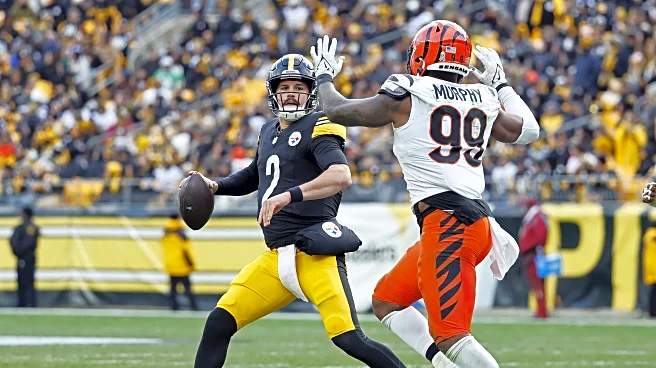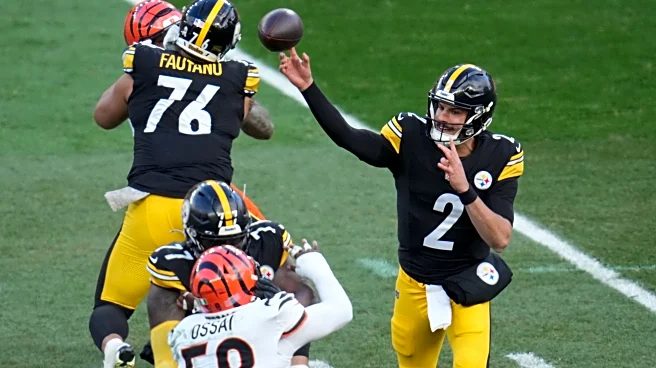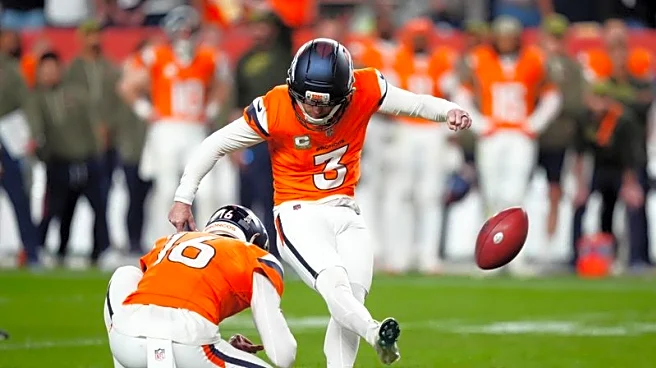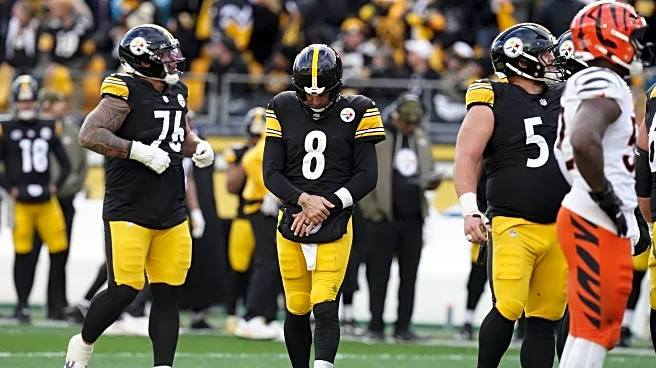The Steelers won big on Sunday, but it feels like everyone is too jaded by the ups and downs of the season to truly enjoy it.
That is, outside of the joys of watching Darnell Washington play football against
regular-sized people. (Whenever I see this video I have to watch it all the way through).
This beautiful display from Mount Washington was deservedly crowned the winner of the Week 11 Angry Runs scepter.
And while there are still some dark clouds hanging over any Steelers’ discourse, Pittsburgh’s 22-point victory over rival Cincinnati provided a taste of revenge and some new narratives for the final half of the season.
What went differently this time against Ja’Marr Chase?

RP: You can start with the stat lines. As everyone remembers, when these two teams met on that fateful Thursday night in October, Ja’Marr Chase went crazy on the Steelers’ secondary, racking up 16 catches for 161 yards (10.1 YPC) and a score.
This past Sunday, the Steelers proved Chase is indeed a mortal man, limiting him to just three catches for 30 yards and no touchdowns. In fact, Pittsburgh only allowed one touchdown all game — to Tee Higgins, who was also limited to just three receptions.
So what changed?
While it’s tempting to look for just one tangible thing that made all the difference, the truth is that it was a collection of small changes that won the day for the Black & Gold. And it’s going to require popping the hood a bit on this defense before we get back to Sunday’s game.
One key difference in this contest was that the Steelers’ secondary looked a lot different than it did just a month ago. When these teams first met:
- Jalen Ramsey was still playing mostly cornerback
- Kyle Dugger was still on the Patriots
- DeShon Elliott was still healthy
- Chuck Clark (61%) and Juan Thornhill (26%) were still getting too many reps at safety
- Brandin Echols played only 36% of the snaps
- Darius Slay played 68% of the snaps.
- James Pierre didn’t register a single snap.
That’s a lot of turnover on the backend of the defense. But notably, the Steelers also switched up tactics with their new personnel arrangements. The Steelers have run predominantly Cover-1 man and Cover-3 this season. That’s notable because those looks feature a single high safety. More recently, especially after the shake-up in the secondary rotation, the Steelers have started to feature more split safety looks.
The Steelers made it a big priority to address the run defense over the offseason, which explains why they leaned so heavily on the single high safety looks this season. By moving one of the safeties up into the box, the Steelers could theoretically be better protected against the run.
The problem?
The foundation of that strategy relied on a few assumptions. One being that the Steelers’ corners would dominate their assignments in man coverage while remaining sticky and tackling soundly in zone. Another, seemingly, was an overconfidence that opponents wouldn’t be able to game-plan around the Steelers’ fierce pass rush.
On top of that, the Steelers were one of the more static defenses in the NFL. What opposing offenses saw pre-snap was most often what they got. That allowed smart coaches and quarterbacks to dice up the Steelers’ secondary, especially on traditional “run downs” like first and second down, when Pittsburgh was most likely to be in a single high safety look.
By pivoting to more split safety, the Steelers defense is able to adjust more flexibly to different offensive formations and motions. They’re also better protected from explosive passing plays, at the risk of being slightly worse against the run with a lighter box — though it’s not like they haven’t had on-again-off-again struggles this season prior to the schematic shift.
That flexibility is on display in the play below. First off, you’ll notice safety Kyle Dugger is anything but static pre-snap. Then, when the Bengals motion running back Chase Brown from out wide and back into the backfield, the Steelers drop Joey Porter Jr. further back, and linebacker Payton Wilson lines up across from Chase.
I could almost hear the Yinzer groans at this point while reviewing this play.
“There go the Steelers, lining up a linebacker against a star wideout again. When will they learn?”
Only, that isn’t exactly how it goes this time.
It ultimately doesn’t work out on this third-down rep as Flacco finds his slot receiver Andrei Iosivas over the middle to convert, but I’m focused more on Chase here. Besides, Cincinnati’s WR3 making a tough snag is preferable to Chase ripping off a huge catch and run.
In the endzone angle of this play, you’ll notice Flacco looks first to his left. I’m sure he was hoping to see Chase racing past Wilson, though perhaps he was just trying to look the coverage off of Iosivas. Either way, this play demonstrated another element of the game plan that became a theme: getting physical with Chase.
The Steelers didn’t press Chase on every passing play, but they were mighty effective when they did. That’s not a given with Chase, who is both fast and one of the most physical receivers in the game. If you try to press him, he will often return the favor while speeding by you to make a big play, as he nearly did on the first play in the reel below.
You’ve got to give a hand to Pierre on that play. Chase (4.34 40-time) is notably a faster player than Pierre (4.59), and beats him badly off the line. Ramsey notices too late that Chase won cleanly off the line, and by the time he starts to adjust, Chase is even with him, which means he’s about to beat the Steelers over the top. But instead, Flacco hangs the ball, and Pierre displays some impressive recovery and ball awareness.
On the first play of the next drive, the Bengals try to find Chase with a similar crossing route to the one they used in their game-winning drive in the previous matchup. This time, there is no miscommunication. Queen does a good job in the early phase of Chase’s route, and Ramsey triggers down as Queen passes him off, delivering a big hit on Chase as he tries to corral a throw that was behind him. That play took longer to develop, and it’s clear Flacco is not as comfortable behind the line when he’s forced to hold onto the ball.
The Steelers’ pass rush was much more effective this time around, and it’s because they were playing much better on the back end. In the October matchup, Flacco had an average time to throw of 2.27 seconds, which is ridiculously fast. He was diagnosing the coverages decisively and letting it rip, to great success. This time, Flacco averaged 2.67 seconds per throw. Only roughly half a second difference might not seem like a big deal, but when you consider the Steelers’ pass rush creates pressure in 2.66 seconds on average (best in the NFL), you realize how much that can impact the game.
The play above was one of my favorite pass rush reps of the game. There are a lot of interesting things happening in it. Breakout star Nick Herbig feints a rush and then drops into coverage. Brendin Echols blitzes from the slot, which pulls the right tackle out wider. That’s one of the reasons it looks like rookie Jack Sawyer is running through the parting of the Red Sea. The other reason? Take a look at our big guys, Cam Heyward and rookie Derrick Harmon, taking on four Bengals linemen between themselves. That’s the kind of trench play that should melt any Yinzers’ heart and make grown men cry tears of joy.
Truly, a thing of beauty.
What went wrong, what went right with PIT’s run defense?
RB: The headlines have been dominated by the Steelers’ quarterback room and impressive performance shutting down the Bengals’ passing game in Week 11.
The run defense? Not so much.
Chase Brown rushed 18 times for 99 yards against Pittsburgh on Sunday, resulting in 5.5 yards per carry. It wasn’t a horrid mark by the Pittsburgh defense, but not a great one, either.
However, I rewatched every run snap from the game and can report back that there aren’t any glaring issues this time around. There were a few rough reps by individual players, but nothing repetitive. All three levels of the defense have taken major strides forward since the early weeks of the season.
Looking at the subpar run defense plays, the first came early in the game and was the result of uncharacteristically sloppy reps from Cam Heyward and Patrick Queen, although I’d put most of the blame on the latter.
Heyward, dealing with two blockers at one point, ends up overpursuing and getting turned around trying to make a play. But Queen has a clearer shot at a tackle and just sort of alligator arms it.
But after that play, both defenders seemed to wake up. Queen had an especially strong outing against Cincinnati.
The other two big runs the Steelers allowed had one thing in common: edge rushers “cheating” inside.
On the first, Pittsburgh gave T.J. Watt an inside rush to open the second half, blitzing safety Kyle Dugger behind him.
The Bengals had a good play call, running directly into Watt’s vacated gap. Tee Higgins does an admirable job blocking Dugger, and linebacker Malik Harrison struggles to release from the tight end’s block. Then, the Steelers turn a good run into a great one, with the second level struggling to bring Brown down.
On the other big (ish) run, this time it’s Nick Herbig who cuts inside. Pittsburgh has bodies on the edge, however, forcing Brown to cut back inside and Queen brings him down for a gain of seven yards.
What I’ve really come to love about watching run defense in the NFL is just how razor-thin the margins for error are. It just takes one bit of poor gap integrity for everything to fall apart. Those above plays were the only truly disappointing reps from Pittsburgh’s run defense on Sunday, but they ballooned Brown’s stat line into productive territory.
However, I talked about some good at the top of this section, so I’ll leave you with a few plays I liked from this unit on Sunday:
Is Roman Wilson the new WR2?

RB: As of Week 11, sure. Wilson out-snapped Calvin Austin III 37-19 on offense, per PFF, recording the second-most snaps of a Steelers wide receiver against the Bengals.
Reviewing Wilson’s tape. It’s perfectly solid. He’s an easy mover, and while he isn’t the most sudden, he has good speed and subtle quickness – the makings of a good route runner.
You can see in the video above that Wilson is still growing, especially when it comes to finding spots in zone coverage, but he was also open more often than his one catch on the afternoon would indicate.
That lone reception against Cincinnati last week, a 17-yard gain on an out route, was a crisp pitch and catch even if Wilson was helped out some by the route concept leading to poor defensive play.
That, of course, begs the question: How did the demoted Calvin Austin III play?
Reviewing Austin’s considerably fewer snaps, I wouldn’t put Wilson in a clear tier above just yet. Austin looked as fast as always, and like Wilson, popped open a few more times than his one-catch-for-five-yards stat line shows.
But a few trends become instantly obvious. Most revolve around Austin’s lack of size at 5’9, 162 pounds (compared to Wilson’s 5’10, 186).
The Steelers seem to prefer having Wilson on the field for run plays. He’s not some superhuman blocker, but he makes a solid effort and his extra 24 pounds help him hold up better.
That’s also obvious on routes. Austin’s quickness leads to a lot of grabbiness from the defensive backs that cover him – often resulting in penalty-worthy plays that aren’t always called – but he doesn’t have the size to consistently succeed against more physical coverage. That was true to the extreme on Sunday:
Wilson, while still not the biggest pass-catcher himself, offers a bit more every-down size. And from a narrative point of view, it’s been good to see the young receiver gain a larger role in the offense after an injury-bitten rookie campaign and near-catastrophic mistake in Week 9 against the Colts.
And it’s worth adding, in both receiver’s cases, that the Steelers’ Week 11 gameplan on offense wasn’t particularly receiver-friendly. In a mix of Arthur Smith’s designs and Aaron Rodgers’ tendencies, Pittsburgh emphasized shallow passes in the flats to its running backs and tight ends to stress the Bengals’ struggling linebacking core.
We’ve seen Wilson make more plays downfield in the past. I’ve especially been impressed by his work on extended plays to still make something happen downfield.
But while Wilson is the shiny new toy in the Steelers’ offense, Calvin Austin III still has plenty of proven production himself.
However, with Austin struggling with drops in recent weeks and the Pittsburgh offense not succeeding much throwing deep, it has made some sense to rotate Wilson in more.
I still wouldn’t call either player a true WR2 at this point in their careers. But the key to unlocking both more might lie in Wilson’s only catch against the Bengals on Sunday. The pre-snap motion helps free up his release and put the defensive back at a disadvantage against his speed.
I wouldn’t overreact to Wilson and Austin’s snap count flip in Week 11. But it didn’t happen for no reason, either.
Should the Steelers rush back an injured Aaron Rodgers?

RP: Aaron Rodgers left the game early last week with what we now know is a fractured left wrist. The severity of his injury remains a bit murky, as there is speculation he could still push to play this week. That said, if he were to miss the game, it’s unclear if he would be back the following week against the Bills, or possibly even later.
On Sunday, Mason Rudolph led the Steelers to 10 points in a strange second half where the Steelers only possessed the ball twice, if you discount the game-ending kneel down.
Rudolph, as he has in the past, performed admirably in relief. That his two drives led to points despite Pittsburgh losing its most consistent offensive weapon in Jaylen Warren to an ankle injury is also impressive, even if it was against the lowly Bengals defense.
This naturally has sparked at least some discourse in the fanbase, as Rodgers really hasn’t looked right for the last month. The question looming on the minds of some Steelers’ fans might even be: are the Steelers better off with Rudolph than Rodgers? At the very least an injured Rodgers?
I find myself in the latter camp. Before the season, Ryland and I broke down Rodgers’ film to try and gauge what strengths and weaknesses he’d be bringing to Pittsburgh at this late stage in his career. Both of us thought Rodgers still had some gas in the tank, but there were also some pretty glaring red flags that could derail his last crusade in the NFL. Namely, his antsy pocket management as he’s grown more cautious of taking hits, and his waning ability to threaten defenses vertically.
In our breakdown, Ryland and I both zeroed in on how Rodgers has looked scared to take hits on plays where he would once have stood tall in the pocket. It’s hard to blame the guy; he’s 41 years old and has a lifetime of tackles racked up on his body. Still, if you need a present reminder of why a quarterback getting twitchy behind the line can be a problem, just put on Rodgers’ tape this year.
The other issue is how limited the Steelers are vertically this season. It’s never a good thing when any area of the field becomes inaccessible to an offense. The Steelers have avoided the middle of the field for nearly five years now, and they’ve been unable to access the intermediate parts (10-19 yards downfield) reliably for nearly as long. But this year, they’ve also shied away from throwing the ball deep, which has allowed defenses to shrink the field on them even further.
When they fail to get successful runs on early downs, or they get penalized, or Rodgers takes a sack, it’s been nearly impossible for them to dig themselves out and extend the series. The first is this stat from Matt Williamson.
The second is that the Steelers have run the fewest plays on offense (555) in the entire NFL. A low success rate at converting first downs, paired with a low volume of plays run is a recipe for an offensive headache. That it still feels better than the 2024 offense was at times, and is definitely better than the Kenny Pickett and Matt Canada years, is a testament to how starved this team and fanbase is for a competent offense.
To Rodgers’ credit, the Steelers rank 12th in PPG (24.6), but I think that largely reflects his ability to capitalize when the defense provides them with favorable field position. As we previously noted, sustaining long drives hasn’t exactly been their jam.
So count me in the group that isn’t in a rush to get Rodgers back. The Green Bay and Los Angeles game were particularly bad performances on his part. Perhaps a week or two of rest and healing is what he needs.
That said, I’m not foolish enough to think that Rudolph is The Answer ™ at quarterback. While he led the Steelers to points on both drives, his skill players did a lot of the heavy lifting. Rudolph mostly threw safe, shallow routes, and as Derrick Bell notes below, there were not many air yards in the Steelers’ receiving totals.
Sure, Rudolph might be more comfortable attacking downfield in a start than in relief — and the Steelers didn’t need him to against Cincinnati with the defense scoring as many touchdowns (2) as the offense did — and we have seen him do it in the past.
But ultimately, I feel like it’s a net neutral for the Steelers. Rudolph theoretically might open up the vertical passing game a bit, but he hasn’t been especially accurate or consistently dangerous doing so thus far in his career. He’s an adequate processor, but he isn’t as quick as Rodgers, and he’s never handled pressure well.
If the defense continues to improve, I think these quarterbacks give Pittsburgh the same chance at winning a playoff game: it’ll rely on matchup. So why not let Rodgers take a week or two to heal up. If the Steelers are going to make the playoffs, do you really think a less than 100% Rodgers gives them the best shot in upcoming games against Buffalo and Baltimore?
I’m not so sure.













